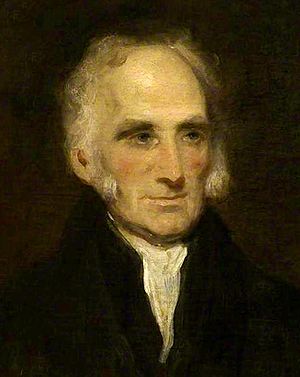Gilbert Blane facts for kids
Quick facts for kids
Sir Gilbert Blane, Bt
|
|
|---|---|

Gilbert Blane by Martin Archer Shee, 1833
|
|
| Born | 29 August 1749 Blanefield, by Kirkoswald, Ayrshire, Scotland
|
| Died | 26 June 1834 (aged 84) |
| Nationality | Scottish |
| Alma mater | Edinburgh University Glasgow University (MD 1778) |
| Known for | Obligatory use of lemon juice to prevent scurvy |
| Scientific career | |
| Fields | Medicine |
| Influences | Lord Rodney William Cullen Alexander Monro Secundus |
Sir Gilbert Blane (1749–1834) was a Scottish doctor. He made big changes to health in the British Royal Navy. He helped sailors stay healthy, especially by fighting a terrible disease called scurvy. Blane's work saved many lives at sea. He also worked as a Commissioner for the Admiralty, focusing on sick and wounded sailors.
Contents
Early Life and Career
Gilbert Blane was born in Blanefield, Scotland, in 1749. He was the fourth son of Gilbert Blane and Agnes McFadzen.
He studied medicine at Edinburgh University and Glasgow University. He earned his medical degree in 1778. After finishing his studies, he moved to London.
In London, Blane became friends with Dr. William Hunter. Hunter was a well-known doctor who helped Blane start his medical practice. Hunter also introduced Blane to Lord Rodney. Lord Rodney was an important naval officer.
Doctor to the Fleet
Lord Rodney chose Blane to be his personal doctor. Blane joined Rodney on his ship, HMS Sandwich. In 1779, Blane became the Physician to the Fleet. This meant he was in charge of the health of all sailors in Rodney's squadron.
Blane traveled with Rodney's fleet to places like Gibraltar and the West Indies. He saw firsthand how sickness affected sailors. He worked hard to make their lives healthier.
Improving Sailor Health
Blane made many improvements to the health of sailors. He focused on better food and cleaner living conditions. He asked other ship doctors for monthly reports. This helped him understand how many sailors were getting sick.
Fighting Scurvy
One of the biggest problems was scurvy. Scurvy is a serious disease caused by not getting enough Vitamin C. It made sailors very weak and sick. Even though a doctor named James Lind had shown in 1753 that fresh fruit could prevent scurvy, the navy had not used his ideas.
In 1780, Blane wrote a guide for ship doctors. It was called On the most effective means for preserving the health of seamen. In this guide, he strongly suggested using citrus juice. He believed it could prevent and cure scurvy.
Later, in 1795, Blane became a Commissioner on the Sick and Wounded Board. He finally convinced the Admiralty to make lemon juice a daily part of the sailors' diet. This was a huge step forward for naval health. Later, limes replaced lemons because they were easier to get from British colonies. This is why British people were sometimes called "limeys."
Other Health Reforms
When Blane returned to Britain, he became a doctor at St Thomas' Hospital. He also became a doctor to the Prince of Wales and later to King George IV and William IV. These important roles helped him build a strong medical practice in London.
The government often asked Blane for advice on public health. In 1795, he became a Commissioner on the Sick and Wounded Board of the Admiralty. He made many important changes. These included providing soap, ensuring good air flow on ships, and making sure medical supplies were the same on all ships. He also helped create the 1799 Quarantine Act. This law helped stop the spread of diseases. Blane left the Commission in 1802.
Helping the Walcheren Expedition
In 1809, Blane gave important medical advice for the Walcheren expedition. This was when British soldiers occupied Walcheren Island. The island had many marshlands, and many soldiers got sick with 'Walcheren Fever,' which was likely malaria. Blane advised the military leaders to remove the troops because of the high risk of sickness.
Because of his help with the Walcheren expedition and his other work for the navy, he was given a special honor. He was made a baronet in 1812. This meant he became "Sir Gilbert Blane of Blanefield."
Blane also believed that every Royal Navy sailor should have a tourniquet. This tool could stop serious bleeding during battles.
His written works include Observations on the Diseases of Seamen (1785) and Elements of Medical Logic (1819).
Death and Family
Gilbert Blane died in London on June 26, 1834. He was 84 years old.
He married Elizabeth Gardiner in 1786. She passed away in 1832.
The Gilbert Blane Medal
In 1830, Sir Gilbert Blane created a special fund. This fund was meant to encourage medical science in the Navy. The money was used to give out gold medals. These medals were awarded to naval medical officers. The officers had to show great skill, hard work, kindness, and knowledge in their jobs.
The famous artist Benedetto Pistrucci designed the medal. He also designed the image of St. George and the dragon on the British gold sovereign coin. The medal is now made of gold-plated Sterling silver. On the back, it says Mente Manuque, which means 'with mind and hand'.
At first, two medals were given out every two years. Sir Gilbert Blane himself helped choose the winners before he died in 1834. In 1913, the rules changed. The medal was then given to the medical officer who scored highest on their exams for promotion.
Today, the Gilbert Blane Medal is still awarded every year. It is given by either the Royal College of Surgeons of England or the Royal College of Physicians. The Medical Director General (Navy) recommends the winner. In 2020, Surgeon Commander Anton Fries received the medal for his work in reconstructive surgery.
Images for kids



